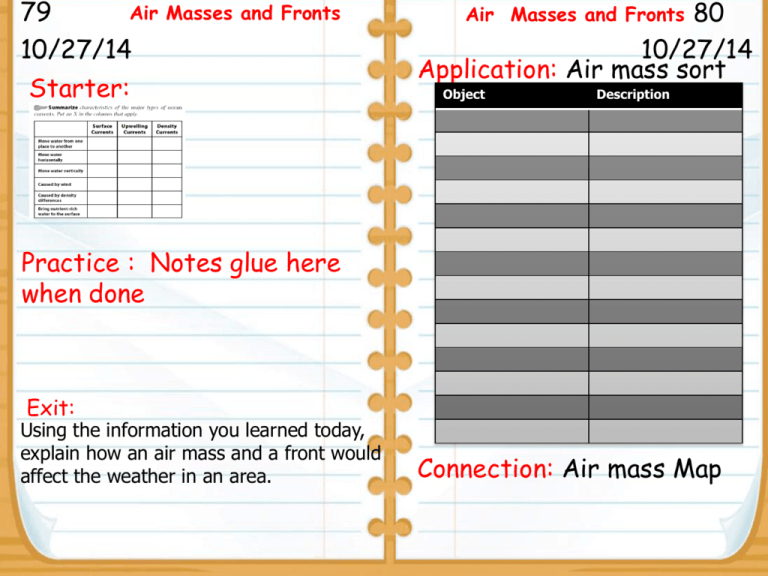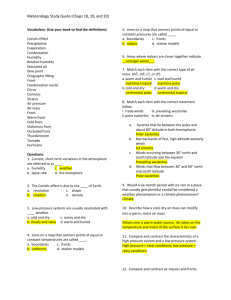Air Masses and Fronts
advertisement

Air 79 10/27/14 Masses and Fronts Starter: 80 10/27/14 Application: Air mass sort Air Masses and Fronts Object Description Practice : Notes glue here when done Exit: Using the information you learned today, explain how an air mass and a front would affect the weather in an area. Connection: Air mass Map January 27, 2014 AGENDA Objectives 8.10 B: Students will identify and recognize how global patterns of atmospheric movement influence local weather using weather maps that show high and low pressures and fronts by reading and writing while completing notes and an activity 1 Starter 2. Practice-Notes 3. Activity 4. Ws 5. Exit Table of Contents Date Lecture/ Activity/ Lab 10/16 Unit 5 vocabulary 10/17 Quiz/Writing 10/20 Weathering Notes 10/21 Weathering Lab 10/22 Climate, Wind and Ocean Currents 10/23 Convection and Ocean Currents 10/24 Wind and Currents Writing 10/27 Fronts and Air Masses Page 65-66 67-68 69-70 71-72 73-74 74-76 77-78 79-80 Air Masses and Fronts Air Masses Air masses have different temperatures and humidity levels When they collide the more dense air mass goes under the less dense air mass There are 5 types and are classified according to where they form: If an air mass forms over land (continental) it has low humidity If an air mass forms over an ocean (maritime) it has high humidity Air masses are either hot or cold Maritime Tropical (mT) Forms over ocean near equator Holds warm, moist air In summer- hot, humid In winter-rain, snow Maritime Polar (mP) Forms over the polar regions Holds cold, moist air During summercooler temps. During winterheavy snow and cold temperatures Continental Tropical (cP) Forms over Mexico only in the summer time. Brings dry, hot air to Southwestern US Continental Polar (cP) & Continental Arctic (cA) Forms over land in North Canada Holds cold, dry air Causes extremely cold temps in the US in winter Continental Arctic Masses only happen in the winter Fronts Fronts are the leading edges of air masses with different air temperature and/or humidity. When a front passes over an area, it is marked by changes in temperature, moisture, wind speed and direction, and precipitation. Cold Front Occurs when a polar (cold) air mass runs into a tropical (warm) air mass The warm air is less dense and gets pushed above the cold air mass Temperatures drop, and there is usually precipitation Thunderstorms are usually a result of a cold front Warm Front Occurs at the place where a warm air mass replaces a cold air mass. The warm air mass is denser and will slowly push the cold air, eventually rising above it. Results in warmer temperatures. Usually precipitation. 3. Occluded Front a. Occurs when a cold front overtakes a warm front b. Has cool temperatures and large amounts of rain and snow 4. Stationary Front a. When a warm air mass meets a cold air mass and no movement occurs b. Brings drizzly rain c. Clear, warm weather afterward 42 Cold Air Warm air 56 Application/Connection AIR Mass Sort With a partner, match the word with the definition that describes it. 151 1/27/14 Air Masses and Fronts Starter: 152 1/27/14 Application/Connection: Air Masses and Fronts Current Activity: Turn in when Glue foldable here and turn in questions. finished Practice : Notes glue here when done Connection/Exit: Relate air temperature to the type of precipitation that will fall.







